What Is The Best Free App For Information On South American Wines
Pocket vino: We review 5 apps for managing your wine cellar
![]() By
By
Freelance Contributor, TechHive |

Today's Best Tech Deals
Picked by TechHive's Editors
Top Deals On Great Products
Picked by Techconnect's Editors
-
VinotekaSoft Vinoteka Classic
-
Pixyapps VinoCellar
-
Snooth Media network Snooth Wine Pro
-
CellarTracker
-
Etecc Interactive Cellar
We've come a long way since the era of the cellar book, when wine bottles had to be logged by hand in paperbound tomes and tracked by little tags hanging from their necks. The wine world is actively embracing technology, and home enthusiasts can get in on the action as well, using mobile apps to help keep their stash tabulated and organized.
Numerous wine cellar management apps are now available, but this is a market that's still emerging and in flux. Growing pains abound, and many of these apps are still finding their feet. In fact, some of the veterans in this space have yet to build a reliable, worthwhile app for what ought to be a pretty simple task.
Which app should you trust with managing some of your most prized possessions? We put five of the most noteworthy wine cellar management apps to the test to separate the gems from the plonk.
Cellar
With the simplistically named Cellar, you know what you're getting right from the start. This extremely basic app is free to download, but it's a 60-day trial. After that, you must pay $10 per month or $100 per year to continue using the app.
The app honestly could not be simpler to use, as all it does is track basic inventory information. Tap the + icon to add a bottle and type in the name of the producer (Cellar offers some suggested wine names as you type, but it's knowledgebase is deathly shallow.)
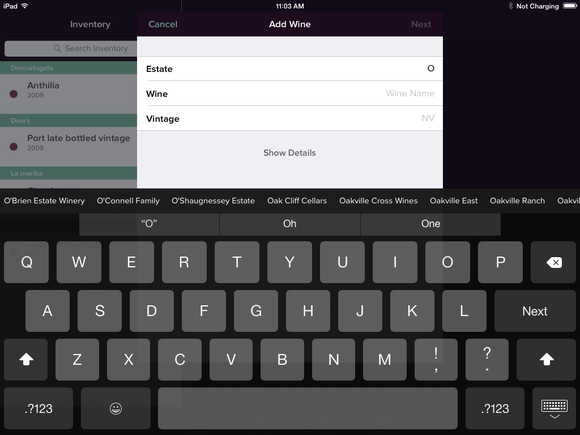
The overly simplistic Cellar in no way justifies the subscription fee its developer expects to collect for oenophiles.
Afterwards, you are required to add a wine name (whether it has one or not), so you'll need to get used to tapping out "Cabernet Sauvignon" on your tablet or phone. Add a vintage and you're finished with the basics. You can then add information to a few additional, optional fields—but the one that matters most, the price of the wine, isn't an option here. There's not even room for notes, ratings, or much of anything else.
When you've added your wines and indicated how many bottles you own of each one… well, you're done. Cellar doesn't manage racks, bins, or handle any other location information, although a timeline feature does at least let you see when you added wines and when you removed them.
Cellar is easy to use, and anyone with a basic grasp of iOS should have no trouble adding information to the system. That said, it's a slow slog with almost no automation, and when you're done, the data isn't very useful. Frustratingly, the app doesn't even automatically capitalize each word in a winery's name as you type it, slowing you down during data entry considerably. However, the app does at least sync automatically and quickly among multiple devices.
Cellar is a harmless app that does the absolute, bare minimum when it comes to wine management. However, you could probably do a much better job by simply using a standard spreadsheet to track your cellar. I'd pay 99 cents for this app, max. A $10 a month subscription fee is downright criminal.
CellarTracker
CellarTracker is primarily a companion app to an online service available at cellartracker.com, but that shouldn't stop you from checking it out even if you've never visited the website. CellarTracker is unique in that it's (sort of) a subscription-based system.

CellarTracker is easily the best app we've seen for managing your wine collection.
The app itself is free, but it does (strongly) ask for a voluntary donation of $40 to $160 per year, depending on the size of your collection, to fund development as you add more and more wines. In the site's own words: "Payments are voluntary and help CellarTracker continue to provide you with excellent service. Most features are free, but some features such as automatic cellar valuation require a minimum payment of $20 per year to access."
Right out of the gate, this app's a winner. CellarTracker has a phenomenal search system that turns up just about everything when you search via keyword, but the real magic is in the service's UPC scanning system. Type in the UPC numbers or use your phone's camera to scan the barcode directly.
Unlike many other systems that promise this kind of functionality, CellarTracker's actually works and works very well. The scanner is fast and intuitive, and there's even a much-needed button that activates your phone's flash bulb to illuminate the UPC when you're in your dark cellar, making the chances for a successful scan much higher.
I had just a few instances with older wines where CellarTracker didn't recognize the UPC (keyword search still worked, though), and only one where the scanner couldn't get a read on the label, probably due to the curvature of the bottle distorting the image.
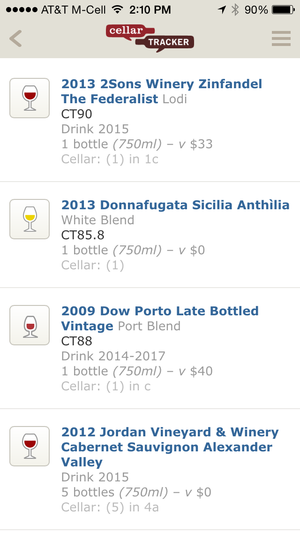
Whoever developed CellarTracker has a real knack for understanding intuitive software design, putting most of the critical functions right where you need them. (Favorite feature: First you add a wine, and then you pick the vintage from a quick panel of common options. Most other databases have a separate entry for every vintage, making it tough to find the exact wine you need.) All told, this app was by a wide margin the fastest and easiest way to digitize my wine cellar information.
CellarTracker doesn't have the fancy graphical cellar representation that VinoCellar and Vinoteka offer; rather, you simply assign a bin number to each wine, and it's up to you to keep your bins straight. But what it lacks in cellar sophistication it makes up for with thoughtful additions you won't find anywhere else. Most notably, CellarTracker includes integrated wine reviews and ratings averages from its legions of users, and access to professional reviews as well (though these cost extra). If you're down with the wisdom of crowds, it's a killer addition.
CellarTracker syncs everything on all devices, automatically and quickly, and—perhaps best of all, considering this lackluster field—it's a rock-solid stable app that never crashed on me once.
Snooth Wine Pro
You would think a service that's been around as long as Snooth (which launched way back in 2007) would have a more robust mobile app, but sadly that's not the case here.
To be fair, Snooth is mainly designed for searching for new wines to buy and tracking the wines you've already consumed. Managing your wine collection in between those two points is not the service's strong point.
The biggest problem with this app is that, by and large, it just doesn't work as advertised. Wines can theoretically be added to your database through two methods: by manually searching for a wine (which mostly works), or by adding a "note." Notes are designed for wines you've already consumed, so this is a little backwards, but it's the only way to add a wine to your cellar by using the camera.
Snooth Wine Pro's visual recognition engine is supposed to be its great selling point, and it's widely touted online: Just take a photo of a bottle of wine and the app will figure out what it is, prepopulating all the informational fields with the bottle's specifics.
Sadly, in my testing (using two different devices on countless bottles of wine), this system did not work at all, not once, not for a single wine. Making matters worse, the note-taking system would not save wines I entered through it at all, even after adding the relevant information by hand. (An email to Snooth's support account asking for help went unanswered.)
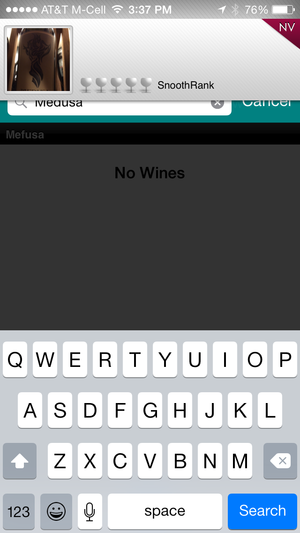
Snooth Wine Pro is surprisingly weak considering its longevity.
Fortunately, the other wine-entry system—reachable by tapping "Search for a wine" on the main menu—works better, saves the information you input, and gives you (very) limited cellar management options. The app only tracks the number of bottles of each wine you have, and not their location. (Location information can, however, can be added on the Snooth website.) Most of your data syncs among multiple devices—albeit slowly—and with the website.
Even for its intended purposes, Snooth Pro just doesn't bring much to the table. For example, tapping the "stores" icon is meant to lead you to nearby wine shops. In my case, two of my neighbors' homes, both of whom operate small wineries, were suggested destinations.
Given Snooth's functionality limitations, poor programming, and overall bad design (with issues like windows overlapping active data entry fields, as you can see in the screenshot), this is an app that seems to have promise, but which is in terrific need of a from-the-ground-up overhaul.
VinoCellar
Widely considered the Cadillac of wine cellar apps, VinoCellar is an exhaustive and often exhausting system for managing everything there is to possibly manage about your wines.
Developed by a French company, there's a considerable learning curve—and some translational challenges—in just getting started with VinoCellar. Wines can be input manually or through keyword search. Using the search system is definitely the way to go, as even marginal pre-population of the dozen-plus information fields allotted to each wine is a huge time saver.
The database isn't nearly complete, with entries skewed toward Old World bottlings, but it's one of the better ones on the market. You'll just want to be careful, as some of the information in the VinoCellar database is quite garbled, such as a baffling listing for a wine by the name of "Oriel Wines $35."
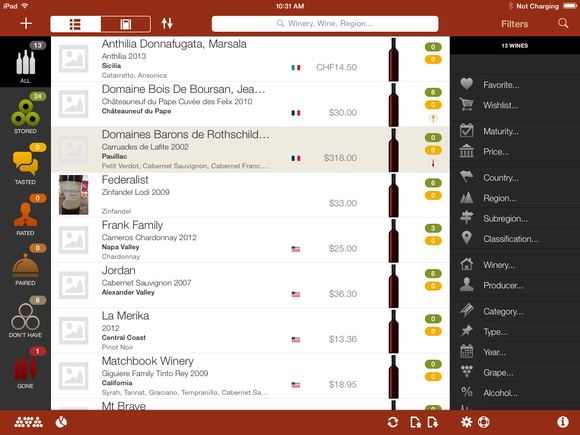
If you're fussy about the finest details of your wine collection, VinoCellar is the app to use.
Once you've created your wine list, it's time to slot the bottles into cellar position. The cellar and rack setup system is surprisingly more complex and quite difficult to work with than creating the wine list. First you must actually set up a visual representation of your cellar, which is initially tricky because the iconography of the app is garbled. For example, you can decide how to number your columns and rows, but the option for setting the legend on columns confusingly shows a picture of the rows, and vice versa. Then, once you've configured the cellar, it's time to slot your wines into their positions.
First, each bottle has to be dropped into a rack, then into a position on that rack on a second screen. This is a tedious process that involves double-tapping an unplaced bottle then double-tapping a spot on the rack. Mess up with a single-tap and you have to start all over.
VinoCellar syncs between various iOS devices (and your cellar can be viewed on the ViniApps website), but sync isn't automatic and must be manually pushed periodically. That said, the app is considerably tougher to interact with on the iPhone vs. the iPad and is more prone to crashing in its smaller version. (Quitting the app completely tends to help, especially with the buggy sync operation.)
VinoCellar's extreme depth of detail—you can specify everything about your bottle, right down to the color of the foil capsule covering the cork and the pH level of the wine inside—makes it the app of choice for extreme cork dorks. More casual collectors may want something simpler and easier to use.
Vinoteka Classic
Vinoteka is developed by a Czech company and is available in three flavors: Classic, reviewed here, is the most full featured. There's also a free version that lets you only keep 10 wine notes (called "references" in this app). And there's a Lite version in development.
Vinoteka is designed as both a system for storing tasting notes and managing your cellar. While it relies heavily on a Comic Sans-esque font for the former, this is actually where the app shines. If you're the kind of person that likes to rate your wines with numerical grades, you'll find a whopping seven different grading systems to choose from to help guide your notes.
Vinoteka includes a search system to help automate the addition of new wines. But text-based search is far from perfect, as it is very limited in its breadth as well as its organization. A typical search for, say, "Jordan Cabernet," includes a white wine from Cline on the first page of results—and zero wines either from Jordan or made from Cabernet. Continued scrolling through the results reveals nothing of use, sending you back to try again.
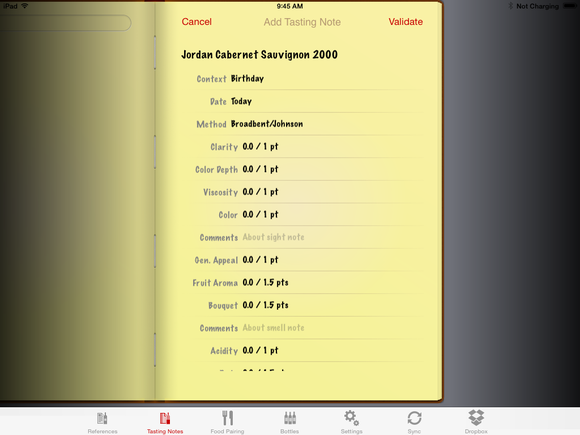
Vinoteka shines when it comes to collecting tasting notes and rating your wines.
The system also lets you search by barcode, either through scanning the code with your camera or entering the UPC digits in by hand. It's a great idea, but I was unable to find a single bottle of wine that showed up in Vinoteka's database via UPC or barcode lookup.
Cellar building is limited within Vinoteka, primarily because of the restrictions over how tall your racks can be. My personal racks are mostly six columns wide and 18 rows tall, but Vinoteka maxes out at 11 rows. Placing wines in the racks is moderately quicker than with VinoCellar, at least, thanks to a more forgiving interface design. As a final note, Vinoteka will sync data only with a Mac running Vinoteka's software and not with another iOS device. Keep this in mind when choosing a device to initially install Vinoteka on.
The bottom line: Users willing to do a lot of work by hand will find Vinoteka capable enough, but its limitations are quite significant.
Note: When you purchase something after clicking links in our articles, we may earn a small commission. Read our affiliate link policy for more details.
-
VinotekaSoft Vinoteka Classic
Users willing to do a lot of work by hand will find Vinoteka capable enough, but its limitations are quite significant.
Pros
- Better cellar-management features than most
- Streaminline wine list view
Cons
- Search functions are largely useless
- Barcode scanner is wholly nonfunctional
- Limited sync options
-
Pixyapps VinoCellar
VinoCellar's level of detail makes it an excellent choice for hardcore wine enthusiasts; more casual collectors will prefer something simpler and easier to use.
Pros
- Extreme level of detail and flexibility in cellar configuration
- Good use of screen real estate, particularly when browsing wines
- Supports multiple devices and online access
Cons
- Complex and prone to crashing
- Incomplete database, particularly with U.S. wines
- Manual synchronization required
-
Snooth Media network Snooth Wine Pro
Snooth Wine Pro just doesn't work as advertised.
Pros
- Database includes wine pricing/value information by default
- Comprehensive review features included
Cons
- Image recognition is broken, along with various other app features
- Generally problematic layout and app design
- Slow to sync
-
CellarTracker
CellarTracker is easily the best app in its class, small as that class might be.And it runs on virtually everything: Android, iOS, and Windows Phone.
Pros
- Versatile, fast, and rock steady
- Entering wines is so easy it's almost fun
- Wide range of devices supported
Cons
- Cellar management system is undercooked
- Guilty feelings if you don't pay for a subscription
-
Etecc Interactive Cellar
An incredibly basic app that is nowhere near worth the subscription fee the developer expects to collect.
Pros
- Extremely simple and basic wine tracking
- Multi-device syncing
- Dull interface
Cons
- Virtually no automation and minimal wine-centric features
- High subscription fee is absurd for such limited functionality
Christopher Null is a veteran technology and business journalist. He contributes regularly to TechHive, PCWorld, and Wired, and operates the websites Drinkhacker and Film Racket.
What Is The Best Free App For Information On South American Wines
Source: https://www.techhive.com/article/2893433/pocket-vino-we-review-5-apps-for-managing-your-wine-cellar.html
Posted by: farrellfroma1981.blogspot.com

0 Response to "What Is The Best Free App For Information On South American Wines"
Post a Comment